图的概念Introduction
- 格式:ppt
- 大小:1.43 MB
- 文档页数:6
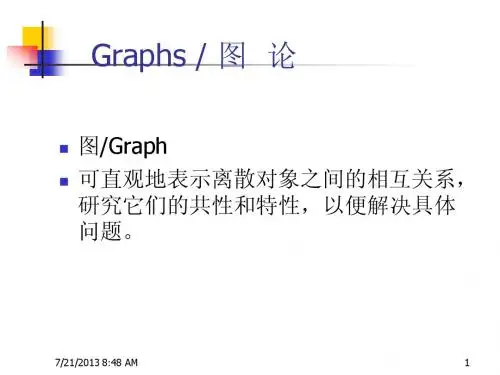

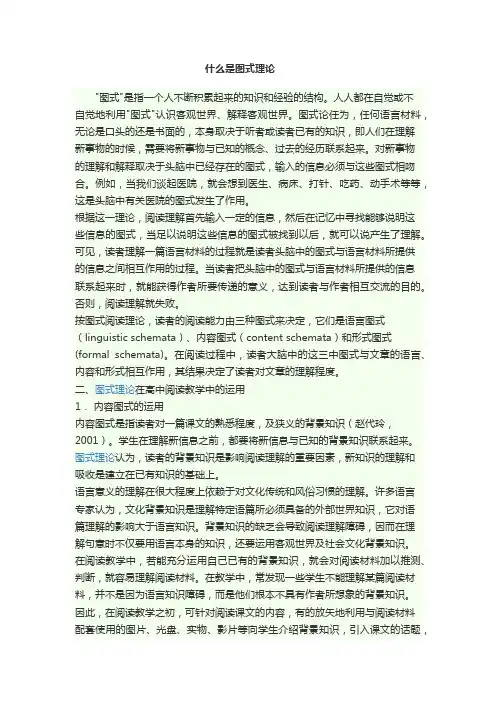
什么是图式理论"图式"是指一个人不断积累起来的知识和经验的结构。
人人都在自觉或不自觉地利用"图式"认识客观世界、解释客观世界。
图式论任为,任何语言材料,无论是口头的还是书面的,本身取决于听者或读者已有的知识,即人们在理解新事物的时候,需要将新事物与已知的概念、过去的经历联系起来。
对新事物的理解和解释取决于头脑中已经存在的图式,输入的信息必须与这些图式相吻合。
例如,当我们谈起医院,就会想到医生、病床、打针、吃药、动手术等等,这是头脑中有关医院的图式发生了作用。
根据这一理论,阅读理解首先输入一定的信息,然后在记忆中寻找能够说明这些信息的图式,当足以说明这些信息的图式被找到以后,就可以说产生了理解。
可见,读者理解一篇语言材料的过程就是读者头脑中的图式与语言材料所提供的信息之间相互作用的过程。
当读者把头脑中的图式与语言材料所提供的信息联系起来时,就能获得作者所要传递的意义,达到读者与作者相互交流的目的。
否则,阅读理解就失败。
按图式阅读理论,读者的阅读能力由三种图式来决定,它们是语言图式(linguistic schemata)、内容图式(content schemata)和形式图式(formal schemata)。
在阅读过程中,读者大脑中的这三中图式与文章的语言、内容和形式相互作用,其结果决定了读者对文章的理解程度。
二、图式理论在高中阅读教学中的运用1.内容图式的运用内容图式是指读者对一篇课文的熟悉程度,及狭义的背景知识(赵代玲,2001)。
学生在理解新信息之前,都要将新信息与已知的背景知识联系起来。
图式理论认为,读者的背景知识是影响阅读理解的重要因素,新知识的理解和吸收是建立在已有知识的基础上。
语言意义的理解在很大程度上依赖于对文化传统和风俗习惯的理解。
许多语言专家认为,文化背景知识是理解特定语篇所必须具备的外部世界知识,它对语篇理解的影响大于语言知识。
背景知识的缺乏会导致阅读理解障碍,因而在理解句意时不仅要用语言本身的知识,还要运用客观世界及社会文化背景知识。
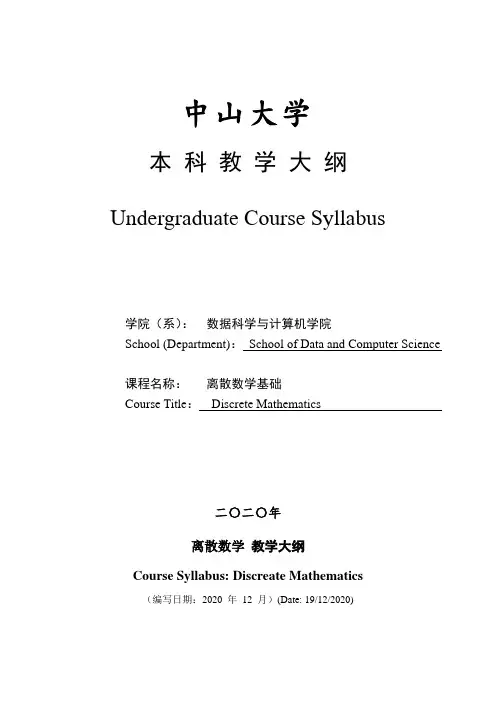
中山大学本科教学大纲Undergraduate Course Syllabus学院(系):数据科学与计算机学院School (Department):School of Data and Computer Science课程名称:离散数学基础Course Title:Discrete Mathematics二〇二〇年离散数学教学大纲Course Syllabus: Discreate Mathematics(编写日期:2020 年12 月)(Date: 19/12/2020)一、课程基本说明I. Basic Information二、课程基本内容 II. Course Content(一)课程内容i. Course Content1、逻辑与证明(22学时) Logic and Proofs (22 hours)1.1 命题逻辑的语法和语义(4学时) Propositional Logic (4 hours)命题的概念、命题逻辑联结词和复合命题,命题的真值表和命题运算的优先级,自然语言命题的符号化Propositional Logic, logic operators (negation, conjunction, disjunction, implication, bicondition), compound propositions, truth table, translating sentences into logic expressions1.2 命题公式等值演算(2学时) Logical Equivalences (2 hours)命题之间的关系、逻辑等值和逻辑蕴含,基本等值式,等值演算Logical equivalence, basic laws of logical equivalences, constructing new logical equivalences1.3 命题逻辑的推理理论(2学时)论断模式,论断的有效性及其证明,推理规则,命题逻辑中的基本推理规则(假言推理、假言易位、假言三段论、析取三段论、附加律、化简律、合取律),构造推理有效性的形式证明方法Argument forms, validity of arguments, inference rules, formal proofs1.4 谓词逻辑的语法和语义 (4学时) Predicates and Quantifiers (4 hours)命题逻辑的局限,个体与谓词、量词、全程量词与存在量词,自由变量与约束变量,谓词公式的真值,带量词的自然语言命题的符号化Limitations of propositional logic, individuals and predicates, quantifiers, the universal quantification and conjunction, the existential quantification and disjunction, free variables and bound variables, logic equivalences involving quantifiers, translating sentences into quantified expressions.1.4 谓词公式等值演算(2学时) Nested Quantifiers (2 hours)谓词公式之间的逻辑蕴含与逻辑等值,带嵌套量词的自然语言命题的符号化,嵌套量词与逻辑等值Understanding statements involving nested quantifiers, the order of quantifiers, translating sentences into logical expressions involving nested quantifiers, logical equivalences involving nested quantifiers.1.5谓词逻辑的推理规则和有效推理(4学时) Rules of Inference (4 hours)证明的基本含和证明的形式结构,带量词公式的推理规则(全程量词实例化、全程量词一般化、存在量词实例化、存在量词一般化),证明的构造Arguments, argument forms, validity of arguments, rules of inference for propositional logic (modus ponens, modus tollens, hypothetical syllogism, disjunctive syllogism, addition, simplication, conjunction), using rules of inference to build arguments, rules of inference for quantified statements (universal instantiation, universal generalization, existential instantiation, existential generalization)1.6 数学证明简介(2学时) Introduction to Proofs (2 hours)数学证明的相关术语、直接证明、通过逆反命题证明、反证法、证明中常见的错误Terminology of proofs, direct proofs, proof by contraposition, proof by contradiction, mistakes in proofs1.7 数学证明方法与策略初步(2学时) Proof Methods and Strategy (2 hours)穷举法、分情况证明、存在命题的证明、证明策略(前向与后向推理)Exhaustive proof, proof by cases, existence proofs, proof strategies (forward and backward reasoning)2、集合、函数和关系(18学时)Sets, Functions and Relations(18 hours)2.1 集合及其运算(3学时) Sets (3 hours)集合与元素、集合的表示、集合相等、文氏图、子集、幂集、笛卡尔积Set and its elements, set representations, set identities, Venn diagrams, subsets, power sets, Cartesian products.集合基本运算(并、交、补)、广义并与广义交、集合基本恒等式Unions, intersections, differences, complements, generalized unions and intersections, basic laws for set identities.2.2函数(3学时) Functions (3 hours)函数的定义、域和共域、像和原像、函数相等、单函数与满函数、函数逆与函数复合、函数图像Functions, domains and codomains, images and pre-images, function identity, one-to-one and onto functions, inverse functions and compositions of functions.2.3. 集合的基数(1学时)集合等势、有穷集、无穷集、可数集和不可数集Set equinumerous, finite set, infinite set, countable set, uncountable set.2.4 集合的归纳定义、归纳法和递归(3学时)Inductive sets, inductions and recursions (3 hours)自然数的归纳定义,自然数上的归纳法和递归函数;数学归纳法(第一数学归纳法)及应用举例、强归纳法(第二数学归纳法)及应用举例;集合一般归纳定义模式、结构归纳法和递归函数。

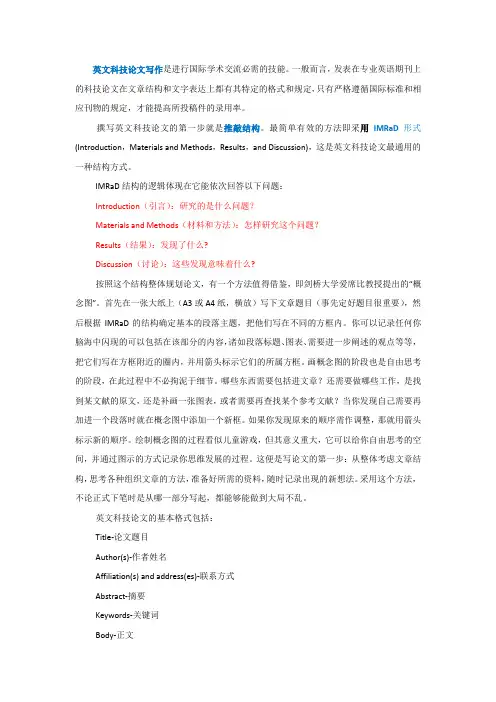
英文科技论文写作是进行国际学术交流必需的技能。
一般而言,发表在专业英语期刊上的科技论文在文章结构和文字表达上都有其特定的格式和规定,只有严格遵循国际标准和相应刊物的规定,才能提高所投稿件的录用率。
撰写英文科技论文的第一步就是推敲结构。
最简单有效的方法即采用IMRaD形式(Introduction,Materials and Methods,Results,and Discussion),这是英文科技论文最通用的一种结构方式。
IMRaD结构的逻辑体现在它能依次回答以下问题:Introduction(引言):研究的是什么问题?Materials and Methods(材料和方法):怎样研究这个问题?Results(结果):发现了什么?Discussion(讨论):这些发现意味着什么?按照这个结构整体规划论文,有一个方法值得借鉴,即剑桥大学爱席比教授提出的“概念图”。
首先在一张大纸上(A3或A4纸,横放)写下文章题目(事先定好题目很重要),然后根据IMRaD的结构确定基本的段落主题,把他们写在不同的方框内。
你可以记录任何你脑海中闪现的可以包括在该部分的内容,诸如段落标题、图表、需要进一步阐述的观点等等,把它们写在方框附近的圈内,并用箭头标示它们的所属方框。
画概念图的阶段也是自由思考的阶段,在此过程中不必拘泥于细节。
哪些东西需要包括进文章?还需要做哪些工作,是找到某文献的原文,还是补画一张图表,或者需要再查找某个参考文献?当你发现自己需要再加进一个段落时就在概念图中添加一个新框。
如果你发现原来的顺序需作调整,那就用箭头标示新的顺序。
绘制概念图的过程看似儿童游戏,但其意义重大,它可以给你自由思考的空间,并通过图示的方式记录你思维发展的过程。
这便是写论文的第一步:从整体考虑文章结构,思考各种组织文章的方法,准备好所需的资料,随时记录出现的新想法。
采用这个方法,不论正式下笔时是从哪一部分写起,都能够能做到大局不乱。

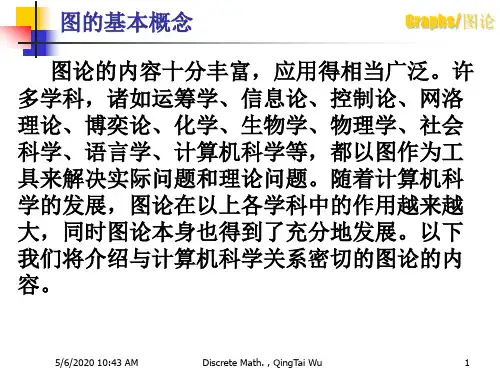


Creating a Map-Guided Route Introduction for Your FriendHey there, [Friend's Name]! I'm excited to share with you a special route that I recently discovered, and I've even crafted a mental map to help you navigate it with ease. Imagine yourself stepping into an adventure tailored just for you, filled with scenic vistas, cultural gems, and delicious eats. Let's embark on this journey together!Starting Point: Jinan Railway StationOur adventure begins right at the heart of the city's hustle and bustle – Jinan Railway Station. This modern transport hub marks the perfect starting point, as it's easily accessible from all corners of the city and beyond. Once you step out of the station, turn left and head straight for about 500 meters.First Stop: Baotu Spring ParkAt this juncture, you'll come across a serene oasis amidst the city's chaos – Baotu Spring Park. This is where our map's first landmark awaits. Step into the park, and let the sound of trickling water wash away your travel fatigue. Walk along the paved paths, admiring the ancient pavilions and lush greenery, all while taking in the main attraction: the Baotu Spring, bubbling with vitality.Next Destination: Daming LakeAfter spending some quality time at the spring, exit the park through the east gate and turn right. Follow the signs leading to Daming Lake, which is about a 15-minute walk or a short cab ride away. Here, you'll find yourself surrounded by vast waters and picturesque scenery. Rent a boat or simply stroll along the lakeside, enjoying the serenity and occasional glimpses of temples and pagodas nestled in the distance.Lunch Break: Local Restaurant by the LakeAs hunger pangs start to set in, head to one of the many local restaurants dotted around the lake. These establishments offer a taste of authentic Shandong cuisine, featuring dishes like braised pork belly, dumplings, and stir-fried vegetables. Savor every bite, as this is a perfect opportunity to indulge in the region's culinary delights.Afternoon Adventure: Thousand Buddha MountainPost-lunch, we venture further afield to Thousand Buddha Mountain (Qianfo Shan). Catch a bus or taxi from the lake area, which should take you about 30 minutes to reach. Once there, embark on a climb that rewards you with breathtaking views,ancient temples, and the iconic Thousand Buddha Cave. Take your time exploring, as each step reveals a new marvel.Evening Return to the City CenterAs the sun begins to set, make your way back to the city center. You might want to stop by Quanfu Street or Huochengquan Road, two historic districts famous for their traditional shops, street food, and lively atmosphere. Spend the evening wandering the streets, shopping for souvenirs, and soaking up the charm of old Jinan.Ending Point: Your AccommodationFinally, after a day filled with adventures and discoveries, return to your cozy accommodation, ready to rest and reminisce about all the wonderful memories you've made.So there you have it, [Friend's Name], a mental map guiding you through a delightful route in Jinan. I hope this journey inspires you to explore more of this beautiful city and create your own unforgettable memories. Happy travels!。
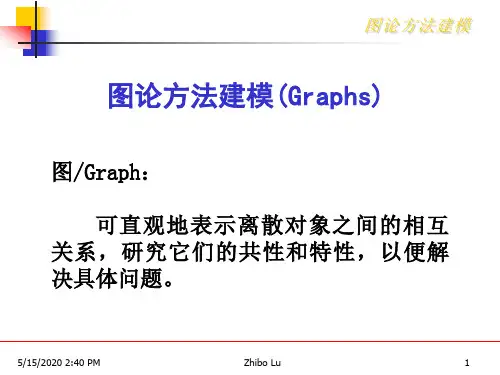
Mapping the Magnificent China: AnIntroduction to the Chinese GeographyThe Chinese geography, vast and diverse, is a testament to the rich history and culture of this ancient land. Spanning across multiple time zones and climatic zones, China's map is a colorful patchwork of natural landscapes and human settlements. From the snow-capped peaks of the Himalayas in the west to the lush tropical rainforests of Yunnan in the south, the geography of China offers a stunning array of visual and cultural experiences.The northern region of China, often referred to as the "heartland," is home to the country's major cities and industrial hubs. Beijing, the capital, sits at the geographic center of this region, surrounded by provinces like Hebei, Tianjin, and Liaoning. This area is also known for its extensive plains and fertile farmland, which supports a significant portion of China's agricultural output.To the east of the northern heartland lies the East China Sea, a vast expanse of blue that borders China's eastern coastline. This region is characterized by itsdense urban populations and high-paced urban life. Shanghai, one of the world's largest cities, is a prime example ofthe region's urbanization and economic prosperity.The south of China, in contrast, is a verdant paradiseof rice paddies, mountains, and rivers. The Yangtze River, the longest river in Asia, flows through this region, nourishing the fertile soil and supporting a richagricultural economy. Guangdong, a province in the southern tip, is famous for its bustling cities and deep-sea ports, which have played a crucial role in China's globalization and economic growth.The western region of China, often described as the "roof of the world," is a land of extremes. Here, the Himalayas and the Qinghai-Tibet Plateau rise to towering heights, covered in snow and glaciers. This region is also rich in natural resources like oil, gas, and minerals, andis home to ethnic minorities who have maintained their unique cultures and traditions.The geography of China is not just a physical landscape; it's a cultural and historical narrative. Each region, with its unique landscape and settlement pattern, hascontributed to the diverse and vibrant culture of China. From the bustling cities of the east to the serene temples of the west, the Chinese geography is a storybook of natural beauty and human endeavor.**描绘壮丽中国:中国地理介绍**中国的地理版图辽阔且多样,充分展示了这片古老土地丰富的历史和文化。
毕业论文研究框架图【Introduction】毕业论文的研究框架图是指在论文写作前,研究者需要对整个研究过程进行规划,通常表现为一张图表,用于概括研究主题、研究目标、研究问题、研究方法等信息。
研究框架图是研究过程的路线图,是论文研究最基本、最核心的部分。
本文主要探讨毕业论文研究框架图的设计原则、内容要素和各部分之间的关系等。
【Design Principles】1. 简洁明了研究框架图的设计应简洁明了,不应该太过复杂,否则会使读者难以理解和把握。
图表应该精简,只呈现必要的信息,使读者一目了然。
2. 重点突出研究框架图应该将研究的重点突出,把握研究脉络,使读者能够明确论文的研究方向和关键思路,帮助读者快速理解研究内容。
3. 一致性研究框架图应该保持一致性,即各个部分之间要有连贯性,尽量避免出现矛盾和重复的情况,使图表更加统一、有序。
【Contents】1. 研究主题研究主题是研究框架图的核心,应该写明该研究的主要内容和研究重点,以帮助读者对整个研究内容有直观的理解。
2. 研究目标研究目标是研究框架图的第二要素,应该注明研究的目的、意义和预期的结果,以指导研究工作的实施。
3. 研究问题和假设研究问题和假设也是研究框架图的核心要素之一,应该明确研究问题和假设,并针对每个问题和假设制定相应的研究方法。
4. 研究方法研究方法是研究框架图中的必要组成部分,研究者应该根据研究的主题和研究问题确定相应的研究方法,并在研究框架图中予以明确。
5. 研究结果和讨论研究结果和讨论也是研究框架图的必要组成部分,研究者应该在图表中明确研究结果和讨论的范围和重点,以便读者更好地理解和掌握研究成果。
【Relationships】各部分之间应该相互补充、联系、协调,尽量避免出现矛盾和重复的情况,使研究框架图更加整体、有序、有逻辑。
【Conclusion】毕业论文研究框架图是毕业论文写作的基础之一,研究者应该对整个研究过程进行充分的规划和设计,以保证毕业论文的实质和完成效果。
思维导图在小学数学教学中的应用思维导图作为一种直观的表达方式,在教学中得到了广泛的应用。
本文将探讨思维导图在小学数学教学中的应用,并结合具体案例进行分析。
本文分为三部分,第一部分介绍思维导图的概念和基本特点;第二部分探讨思维导图在小学数学教学中的应用;第三部分以实例进行分析,突显思维导图在小学数学教学中的作用。
二、思维导图的基本特点思维导图是一种非线性的思考方式,它以中心点为基础,发散而不受限制,采用颜色、形状、线条等辅助工具,辅助人们组织思路和信息。
思维导图具有如下特点:1. 多重性:思维导图采用概念树的形式,可以同时显示多个主题和子主题。
2. 层次性:思维导图的结构可以清晰地显示出主题之间的层次关系。
3. 易读性:思维导图采用简单明了的符号来表示主题和子主题之间的关系,易于阅读和理解。
4. 非线性:思维导图的结构是发散的,没有固定的先后顺序。
5. 可视性:思维导图将复杂的信息以图形的方式呈现出来,方便记忆和观察。
三、思维导图在小学数学教学中的应用1. 概念整合小学数学涉及的知识点繁多,想要系统化学习这些知识,就需要通过概念整合来归纳总结。
思维导图可以通过分支的形式将概念有机地联系起来,促进学生对知识的整合和学习。
例如,在小学一年级的数学教学中,可以通过思维导图的形式整合箭头、长短、粗细等的概念。
学生通过思维导图的帮助,理解这些概念之间的联系和区别,从而更好地掌握这些知识点。
2. 解决问题小学数学中的问题往往比较实际和简单,但对于学生来说,仍需要一定的思考和探究才能解决。
思维导图可以帮助学生将要解决的问题进行分类,并找到解决问题的正确方向。
例如,在小学二年级数学教学中,学生需要解决“海星有多少个脚”的问题。
教师可以先在黑板上画出思维导图,将问题中涉及的概念(海星、脚)分别列出,然后通过通过分类计算,帮助学生解决问题。
3. 组织思路小学生的思维方式比较简单,需要训练他们系统化思维能力。
思维导图可以有效地锻炼学生的系统化思维能力,增强他们的理解和记忆能力。
常用英汉翻译Conceptual planning design 概念规划设计Planning & Architectural design 规划与建筑设计Background And Existing Condition 背景与现状Concept And Strategy 概念与策略Node Detail 节点设计Perspective 效果图Budget Estimate 预算Master Plan 总体规划Architectural 建筑Introduction 概述Unit Design 户型设计Illustration 效果篇Urban Design 规划篇Architecure 建筑篇Landscape 环境篇Feature 景观篇Commercial、Hotel、Kindergarten 商业、酒店、幼儿园Contents 目录Site 区位分析Concept 概念构思Function analysis 功能分析Site plan 总平面图Traffic analysis 交通分析Space analysis 空间分析Floor plan 各层平面图Elevation 立面图Section 剖面图B ird’s view鸟瞰Perspective 透视图Night scenes 夜景Residential 住宅Elementos Urbanos 城市元素Road Section 道路断面Landscape Node 景观节点Graphic 平面Master Layout Plan (MLP) - Option各层平面图的英语表示一层平面图1ST FLOOR 二层平面图2ND FLOOR 三层平面图3RD FLOOR 四层平面图4TH FLOOR 五层以上平面图5TH – TOP FLOOR规划与建筑设计ARCHITECTURE & PLANNING DESIGN前期分析FRONTEND ANALYSIS区位LOCATION现状分析SITE ANALYSIS项目优势Advantage设计目标DESIGN OBJECTIVE项目定位POSITION规划思路Study规划设计Planning过程方案PREVIOUS OPTION现方案CURRENT OPTION总平面图MASTER PLAN分析图ANALYSIS平面功能PLANS & FUNCTIONS各层平面图FLOOR PLANS放大平面Enlarge Plan场地剖面图SITE SECTION竖向设计Level建筑立面BUILDING ELEVATION透视图Perspective鸟瞰Bird’s Eye View产品设计UNITS DESIGN星级会所LUXURY CLUBHOUSE独栋别墅Villa合院别墅Courtyard Villa叠拼别墅Stack House联排别墅Town House高层豪宅High Raise RESI方案对比Scheme contrast。